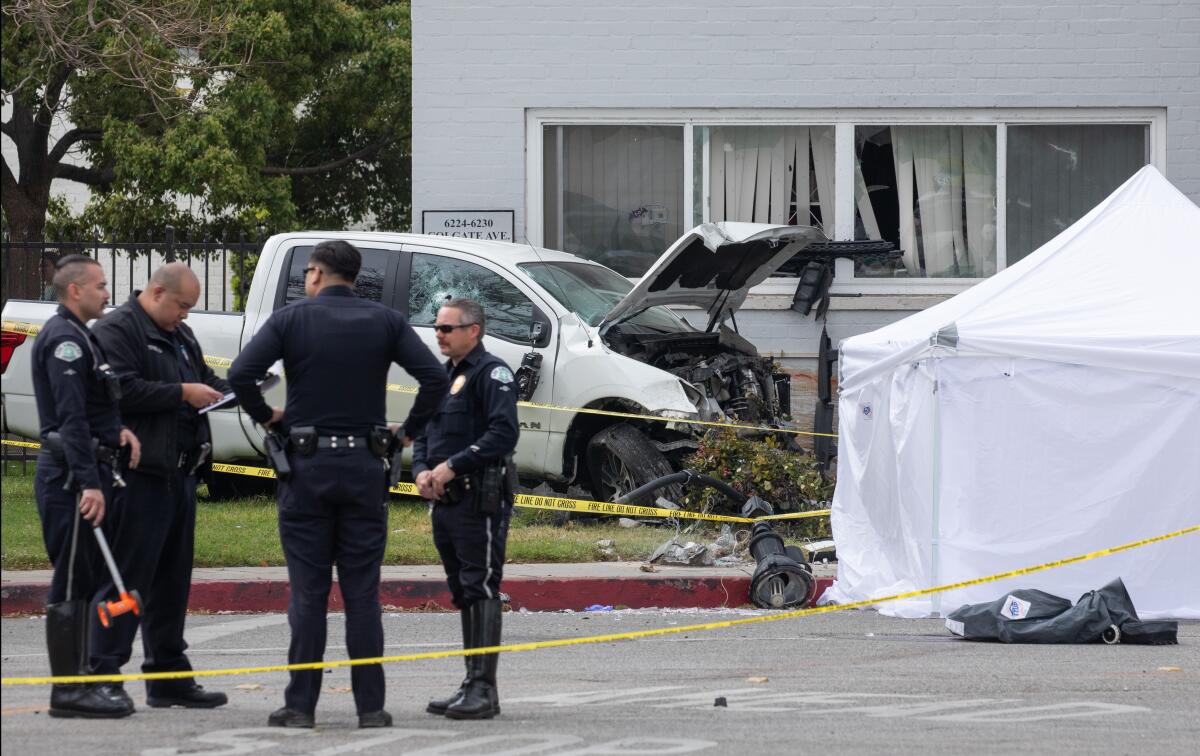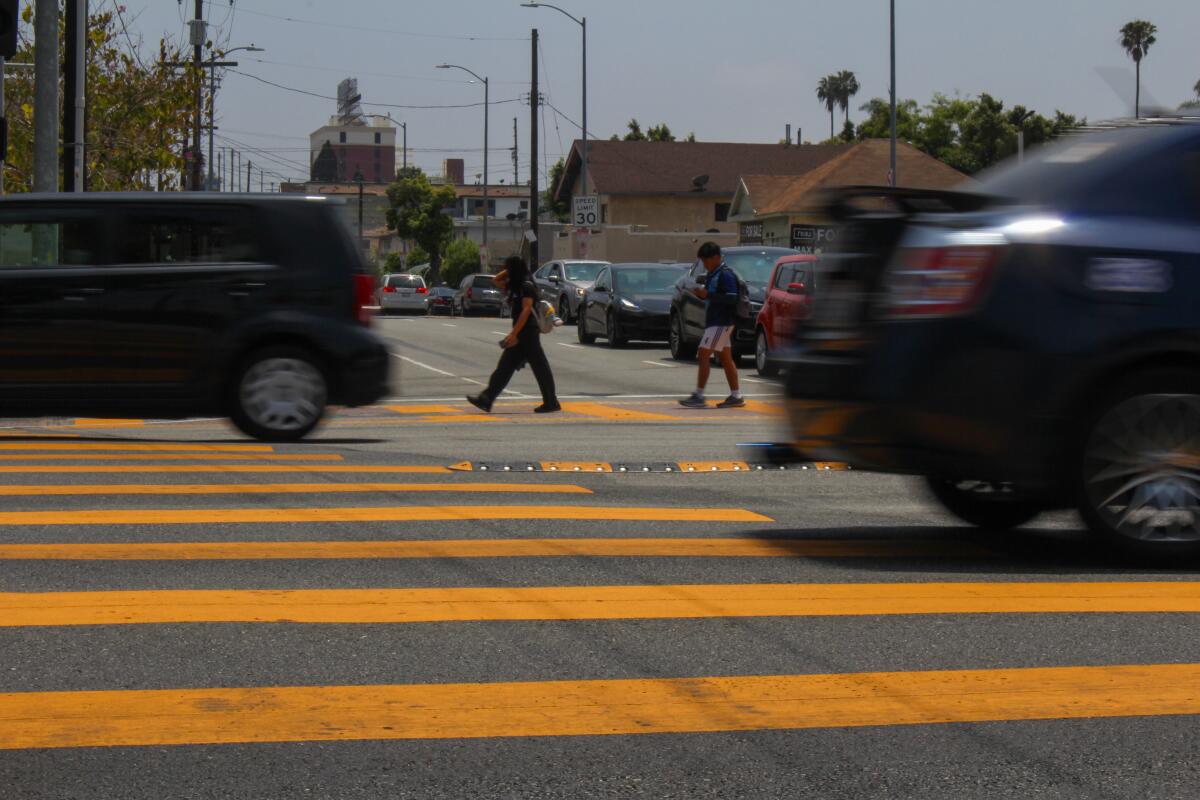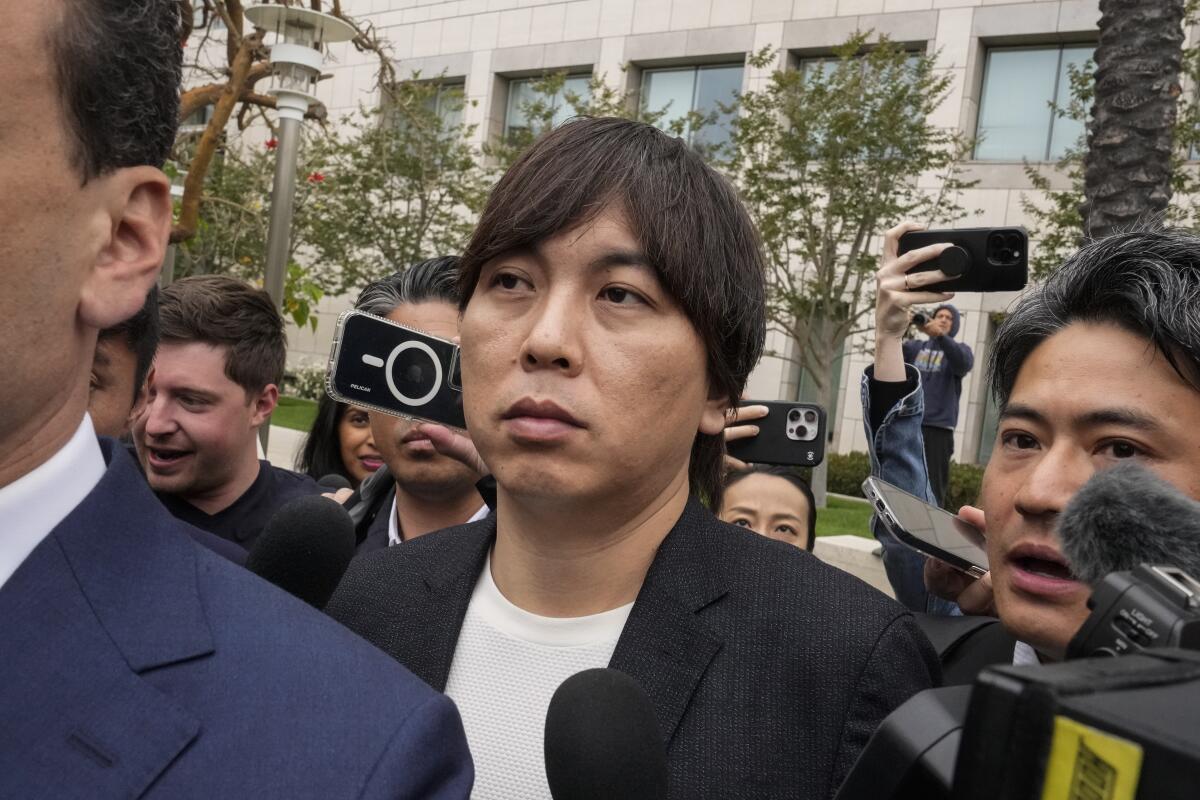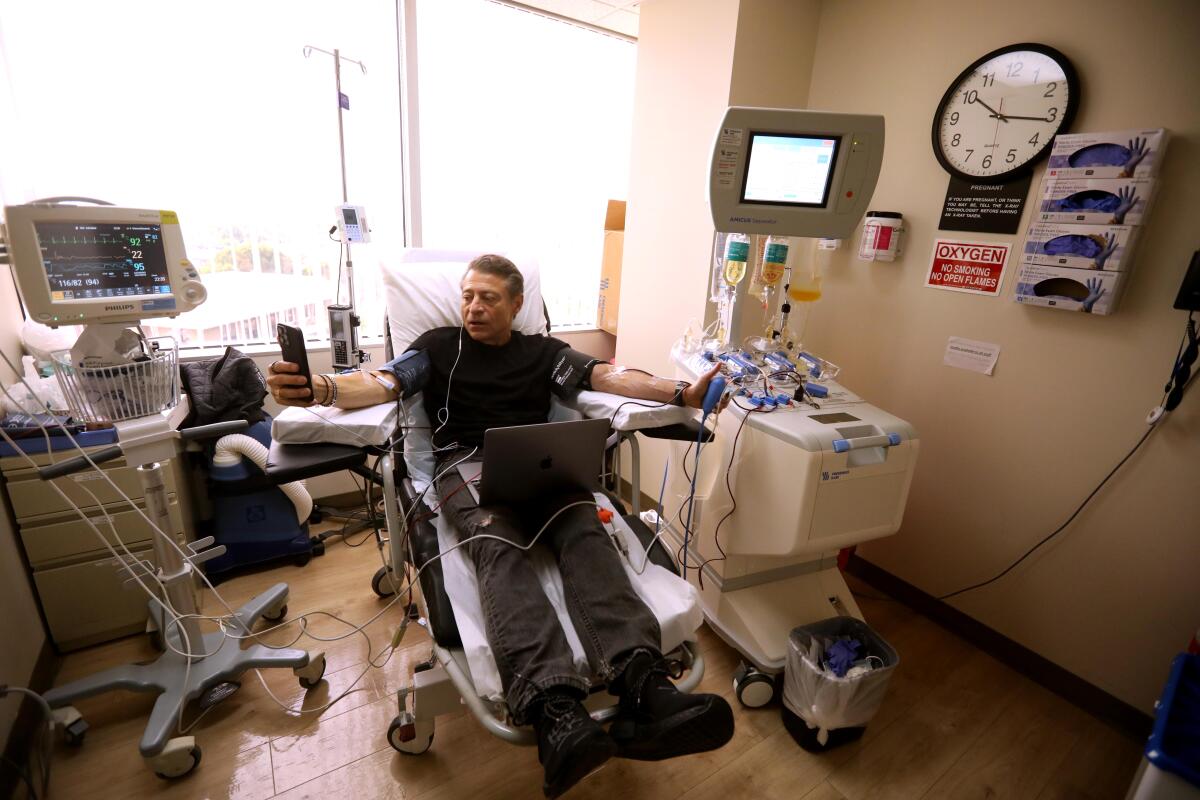When it comes to deadly streets, should we blame drivers less and design more?

- Share via
Good morning. It’s Wednesday, June 5. Here’s what you need to know to start your day.
- Who’s responsible for the rise in traffic killings?
- Shohei Ohtani has been formally cleared by MLB of any involvement in gambling
- Ten joyous L.A. spots to queer your weekend
- And here’s today’s e-newspaper
You're reading the Essential California newsletter
Our reporters guide you through our biggest news, features and recommendations every morning
You may occasionally receive promotional content from the Los Angeles Times.
Rethinking responsibility as traffic killings mount
In nearly five years since I started reporting on Alessa Fajardo, a 4-year-old who was struck and killed by a driver in Koreatown as she walked to school with her mother, I’ve learned a lot about the layers of responsibility that exist in traffic killings.
In today’s newsletter, I want to explore more of those layers.
First, let’s talk about the driver
The woman who killed Alessa with her SUV has not been found liable in civil court. She has also avoided accountability in criminal court for nearly four years.
LAPD investigators said the driver, Indira Marrero, was not speeding or under the influence when she hit Alessa and her mom as they legally used a marked crosswalk. She cooperated with police at the scene and was not arrested. She told police she did not see them in the crosswalk.
Marrero was charged months later with misdemeanor vehicular manslaughter, which often carries sentences like probation and/or a short stint in jail. She did not show up for her arraignment in November 2020 and a warrant remains out for her arrest, according to Ivor Pine, spokesperson for the L.A. City Attorney’s office.
I’ve written previously about the range of consequences for drivers who kill someone with their car. Some say the rarity of more serious felony charges points to a car-centric culture, which prosecutors aren’t confident they can break through to win cases.
But it goes beyond just the driver.
Alessa’s parents filed a wrongful death lawsuit against the city, arguing that it also bore responsibility for the preschooler’s death. The family’s attorneys said the city knew the intersection was dangerous and did not act to make it safer until after Alessa was killed. Documents show city officials knew for years that schoolchildren were at particular risk around Alessa’s school.
The city paid the Fajardos $9.5 million to settle the case.
Challenging the role street design plays

Alessa was one of an estimated 143 people killed by drivers while walking in L.A. in 2019. Over the next four years, another 563 pedestrians died in crashes on city-managed streets. Hundreds more were severely injured during that time.
Roads can be built to discourage or enable dangerous driving. Higher speeds create higher risk of crashes — and increase the likelihood that a collision will be severe or deadly.
Wes Marshall, a professor of civil engineering at University of Colorado, Denver, believes it’s well past time for traffic engineers to correct a century’s worth of mistakes. He said safety has historically been an afterthought on streets designed to move cars as quickly as possible.
“[Engineers have] been around for maybe 100 years and we’re still at the point where we’re killing more people than we save,” he told me earlier this year.
Marshall examined the history of transportation planning in his new book “Killed by a Traffic Engineer.” He argues that early road designers’ attempts to establish order from early automobile chaos had little basis in science, but have become widely accepted norms.
A growing number of transportation experts say to actually make streets safer and save lives requires dramatically redesigning roads to slow down car traffic and compel drivers to pay more attention — a concept known as self-enforcing streets. Some cities in the U.S. (and whole countries in Europe) have actually reduced or eliminated traffic deaths on their streets after investing in that approach.
But those changes take political will that critics say L.A. leaders have mostly been unwilling to demonstrate, with deadly results. That speaks to the automobile’s powerful position at the top of the transportation hierarchy, fueled by a notion of American exceptionalism.
“You look to see what a lot of other countries and cities are doing and they’ve reduced road fatalities and severe injuries down to a fraction of what we’re seeing,” Marshall said. “We’re failing and I think people now realize that and that the lives we’re losing on the streets are because we haven’t done anything about it — and that we can do something.”
Alessa’s death highlights inequities in which neighborhoods get safety priority
Some neighborhoods get upgrades funded and installed within months, while others wait years.
Long delays to improve safety at the intersection where Alessa was killed “speaks to a lack of streamlined approach” by the city, according to Madeline Brozen, deputy director for the UCLA Lewis Center for Regional Policy Studies.
Conditions in the predominantly non-white, low-income neighborhood where Alessa’s family lives highlight the race- and class-based inequities of traffic violence. Black and brown residents are disproportionately killed in traffic collisions in L.A. and many communities across the U.S.
“In the last five years, one of every three traffic deaths in L.A. is a Black or Latino pedestrian, up from one in four in 2013-2017,” Brozen told me, citing a policy brief she co-authored earlier this year. “This is a safety crisis and we need a city process that brings improvements to communities as quickly as possible and doesn’t spend more on settlements than infrastructure.”
L.A. officials have acknowledged a harmful legacy of “systemically racist policies and practices that disproportionately and intentionally impacted” communities of color and have vowed to change that.
More Angelenos are waking up to the dangers their streets pose
In 2015, the city adopted Vision Zero, an international street safety strategy to reduce and eventually eliminate traffic deaths by addressing poor design and ineffective enforcement.
But since then, traffic deaths have soared in L.A.. The number of pedestrians killed by drivers more than doubled over 10 years.
Safety advocates say it’s not that Vision Zero doesn’t work; it’s that city officials too often delay or kill the sorts of safety projects it calls for, citing concerns about slowing down car traffic.
Many Angelenos are fed up by the lack of progress. A group known as Crosswalks Collective LA began painting their own unsanctioned crosswalks, adopting the mantra: “The city of Los Angeles doesn’t keep us safe so we keep us safe.” The city has removed many of their DIY safety features, but made some permanent.
And the momentum is shifting.
L.A. voters recently approved Measure HLA, a citizen-sponsored ballot initiative that legally mandates the city to follow a mobility plan its leaders adopted nearly a decade ago. That plan identifies hundreds of miles of city streets for new infrastructure to better protect pedestrians and cyclists.
State rules for setting speed limits were amended to give cities more authority to reduce speed limits. A bill signed by Gov. Gavin Newsom last year will allow L.A. and five other California cities to try out automated speed cameras in school zones and other streets with a history of traffic violence.
Marshall believes changes like those could help end L.A. streets’ deadly notoriety.
“I think it’s getting a much better reputation now, because of those more recent changes in policy,” he said. “That really should help [create] safer streets — if people care enough to push on those things.”
Today’s top stories

Shohei Ohtani interpreter scandal
- Ippei Mizuhara, ex-interpreter for Shohei Ohtani, pleads guilty to fraud in betting case.
- Shohei Ohtani has been formally cleared by MLB of any involvement in gambling.
- Shohei Ohtani puts interpreter scandal behind him but extends slump in Dodgers’ loss.
Crime
- ‘He was completely nude’: A ride-share driver shoots a naked man attacking a woman in OC.
- Music producer The-Dream has been sued over allegations of sex trafficking, battery and rape.
- Six tourists were zip-tied and robbed in a Hollywood home invasion, reports say.
Climate and environment
- California’s scorcher: Heat wave likely a preview of what’s to come this summer.
- Heat wave or heat dome? Yes, there’s a difference.
- Whittier planned to cut down more than 80 ficus trees. Then came the outrage.
- Regulators reject Berkeley plan that would have allowed ‘excessively high’ radiation at park.
- Bird flu detected in San Francisco wastewater and chickens.
- Newsom praises court ruling dismissing environmental groups’ challenge of Sites Reservoir.
More big stories
- Warner Bros. Discovery is raising Max prices. Here’s how much it’ll cost you.
- Biden signs order closing the border with Mexico when crossings surge.
- Paramount Global unveils business plan and job cuts as sale looms.
- Do you return your shopping cart? A psychologist’s answer on TikTok enraged thousands.
- $10,000 to care for the aging ‘Shrek’ donkey and friends? One Palo Alto council member says neigh.
- Overwhelmed by student loans? A free new California program can help you.
- Older men die by suicide at steep rates. Here’s how the VA is trying to change that.
- Through photos, essays, stories, videos and more, The Times is profiling individuals who are shaping the contours of the city. This week, we’re introducing The Creators, visionaries who are influencing film, art, music and other sectors of entertainment.
- Hunter Biden’s words come back to haunt him as trial on gun charges begins.
- L.A. County wants to cap rent hikes at 3%. Landlords say that would push them to sell.
- California will refund more than $52 million to federal government for immigrant care.
Get unlimited access to the Los Angeles Times. Subscribe here.
Commentary and opinions
- Mary McNamara: Inside Hollywood’s most impressive summer production: ‘Bridgerton’ marketing blitz.
- Robin Abcarian: House Republicans would rather demonize Anthony Fauci than help Americans survive the next pandemic.
- Mark Z. Barabak: Trump’s conviction offers a character test — of America and its values.
- Anita Chabria: Addiction is messy, as the Hunter Biden trial proves.
- Editorial: California is facing another record-breaking hot summer. We aren’t ready.
Today’s great reads
Can money conquer death? How wealthy people are trying to live forever. Therapeutic plasma exchange is typically done to treat a number of diseases, but as far as Peter Diamandis knows — and he has gone to great lengths to know — he is in excellent health. Instead, he’s using it prophylactically as part of the $120,000 he spends every year to live as long as possible.
Other great reads
- ‘I’ll break you! I’ll get you!’ — why these 6 comic actors need to make ’em laugh.
- At Contact in the Desert, ‘Coachella for UFOs,’ a once-fringe topic takes the main stage.
- For ‘Abbott Elementary’s’ will-they-or-won’t-they couple, the fun is in the messiness.
- Marlon Wayans finds comedy in his grief, just like his parents taught him.
How can we make this newsletter more useful? Send comments to [email protected].
For your downtime
Going out
- 🏳️🌈 Ten joyous L.A. spots to queer your weekend.
- 🎭 Imperfect, yes, but ‘Jelly’s Last Jam’ is still wildly entertaining in revival at Pasadena Playhouse.
- 🥾Tell us: What’s your favorite L.A. hike?
Staying in
- 📺 ‘Clipped’: The real story about Donald Sterling, V. Stiviano and the Clippers— now streaming on Hulu.
- 🧑🍳 Here’s a recipe for Salvadoran sopa de res.
- ✏️ Get our free daily crossword puzzle, sudoku, word search and arcade games.
And finally ... a great photo
Show us your favorite place in California! We’re running low on submissions. Send us photos that scream California and we may feature them in an edition of Essential California.

Today’s great photo is from restaurant critic Bill Addison. Bill caught the table side chef in the middle of a bananas foster preparation at the Carbone at Aria Resort & Casino in Las Vegas.
Have a great day, from the Essential California team
Ryan Fonseca, reporter
Defne Karabatur, fellow
Andrew Campa, Sunday reporter
Kevinisha Walker, multiplatform editor and Saturday reporter
Christian Orozco, assistant editor
Stephanie Chavez, deputy metro editor
Karim Doumar, head of newsletters
Check our top stories, topics and the latest articles on latimes.com.
Sign up for Essential California
The most important California stories and recommendations in your inbox every morning.
You may occasionally receive promotional content from the Los Angeles Times.






